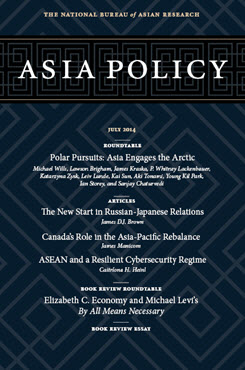Asian Interests in the Arctic
Risks and Gains for Russia
This essay is part of the roundtable “Polar Pursuits: Asia Engages the Arctic.”
In recent years, the Arctic has become a key area of interest for Russian domestic and foreign policymakers. Russia’s renewed attention to the region and its readiness to spend enormous resources on development there have been driven by several closely interconnected factors. These include both the will to seize opportunities, primarily economic ones, as the Arctic opens up and the need to secure Russian sovereign rights in the region. Another factor has been the surge of interest in Arctic matters expressed by countries around the world, including by Asian states. This trend has fueled Moscow’s determination to defend the Russian position against the perceived threat of being pushed out of the region by foreign actors eager to develop their own activities.
For some time, Russia has been reluctant to accept increased influence in the region by non-Arctic actors that could potentially challenge Russia’s status and interests. This coolness to newcomers applies to the Arctic Council’s new Asian observers—China, Japan, India, South Korea, and Singapore—as well as to outside states and organizations in general. Although Russia intends to strengthen cooperation in the future, such cooperation is to occur on one condition: it must not challenge Russia’s sovereign rights in the Arctic, including offshore areas.
This essay analyses Russia’s attitudes toward Asian interests in the Arctic. First, it examines Russia’s key Arctic interests and policies and the challenges to their implementation. Next, it sheds light on Moscow’s views on the admission of the five Asian states as observers in the Arctic Council, as well as on the motivations behind their policies toward the region. Finally, the essay analyses Russia’s views on the actual and potential risks and gains as it seeks to balance mutually beneficial cooperation with the need to preserve its own influence, rights, and interests in the Arctic.
Russia’s Arctic Interests: New Opportunities, New Uncertainty
Russian policy fundaments, the resulting Arctic strategy, and the plan for its implementation all draw on the country’s relatively high-tempo socioeconomic and security development program and ambitions for the energy sector, strategic minerals and metals mining, maritime shipping, and fisheries. [1] One of Russia’s key strategic goals is the transformation of the Arctic into the “foremost strategic base for natural resources” by 2020. The expansion of the energy sector, which is monopolized by the national oil companies Gazprom, Rosneft, and more recently Zarubezhneft, has been moving forward, although dogged by delays. Some plans, including one to develop the Shtokman gas field in the Barents Sea, were canceled after the U.S. shale gas revolution altered the geopolitics of energy.
Another fundamental Russian goal in the Arctic is development of the Northern Sea Route (NSR) as a major shipping artery to challenge traditional trade lanes between Europe and Asia. The use of the route for both transit and destinational shipping has risen systematically since 2009, and the government has high expectations for the future. [2] However, the development of the NSR depends on the scope of economic development in the Arctic, even as many Arctic development projects depend on the availability of the NSR. To make Arctic shipping easier and safer, Russia has embarked on a large-scale plan to revitalize the passage through legislative and economic means as well as the use of security and military assets. Plans include construction of a new generation of icebreakers, modernization of search-and-rescue services, management of communications, development of navigation and surveillance systems, and development of a comprehensive dual-use coastal infrastructure that would serve Russian military and civilian purposes alike.
As the Arctic becomes more accessible and the number of states and organizations active in it grows sharply, the region is seen by many in Russia as increasingly vulnerable. As a result, the Russian government has been strengthening security and defense forces in the Arctic, primarily…
Endnotes
[1] For the Russian policy fundaments, see Government of the Russian Federation, Osnovy gosudarstvennoi politiki Rossiiskoi Federatsii v Arktike na period do 2020 goda i dal’neishuyu perspektivu [Foundations of the State Policy of the Russian Federation in the Arctic for the Period Up to 2020] (Moscow, September 18, 2008); and Government of the Russian Federation, Strategiya razvitiya Arkticheskoi zony Rossiiskoi Federatsii i obespecheniya natsional’noi bezopasnosti na period do 2020 goda [Strategy for Development of the Arctic Zone of the Russian Federation and for Provision of National Security for the Period Up to 2020] (Moscow, February 20, 2013), http://government.ru/news/432. For the plan for the implementation of the Arctic strategy, see Plan meropriyatii po realizatsii strategii razvitiya Arkticheskoi zony RF i obespecheniya natsional’noi bezopasnosti do 2020 [Plan of Measures Aimed at Realization of the Strategy for the Development of the Arctic Zone of the Russian Federation] (Moscow, October 16, 2013).
[2] The Ministry of Transport estimates a potential increase of cargo transport to around 64 million tons by 2020 and 85 million tons by 2030, “Severnyi Morskoi put’ uvelichit gruzooborot v 50 raz” [The Northern Sea Route Will Increase Transport of Goods 50 Times], Izvestiya, August 7, 2011. The vice minister of transport Viktor Olerskii says the cargo transport may reach 50-80 million tons by 2030. See Ivan Yegorov, “Otkryli Arktiku” [They Discovered the Arctic], Rossiiskaya gazeta, April 12, 2013.
About Asia Policy
Asia Policy is a peer-reviewed scholarly journal presenting policy-relevant academic research on the Asia-Pacific that draws clear and concise conclusions useful to today’s policymakers. Asia Policy is published quarterly in January, April, July, and October and accepts submissions on a rolling basis. Learn more


